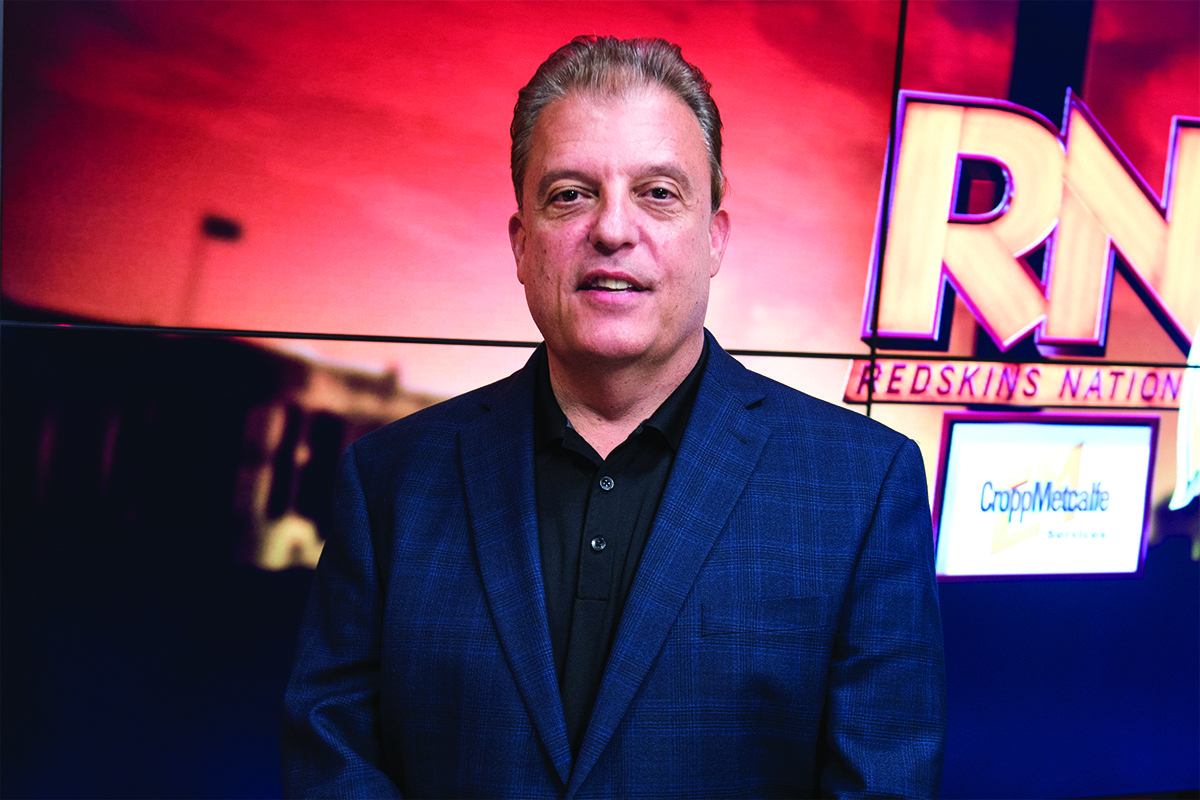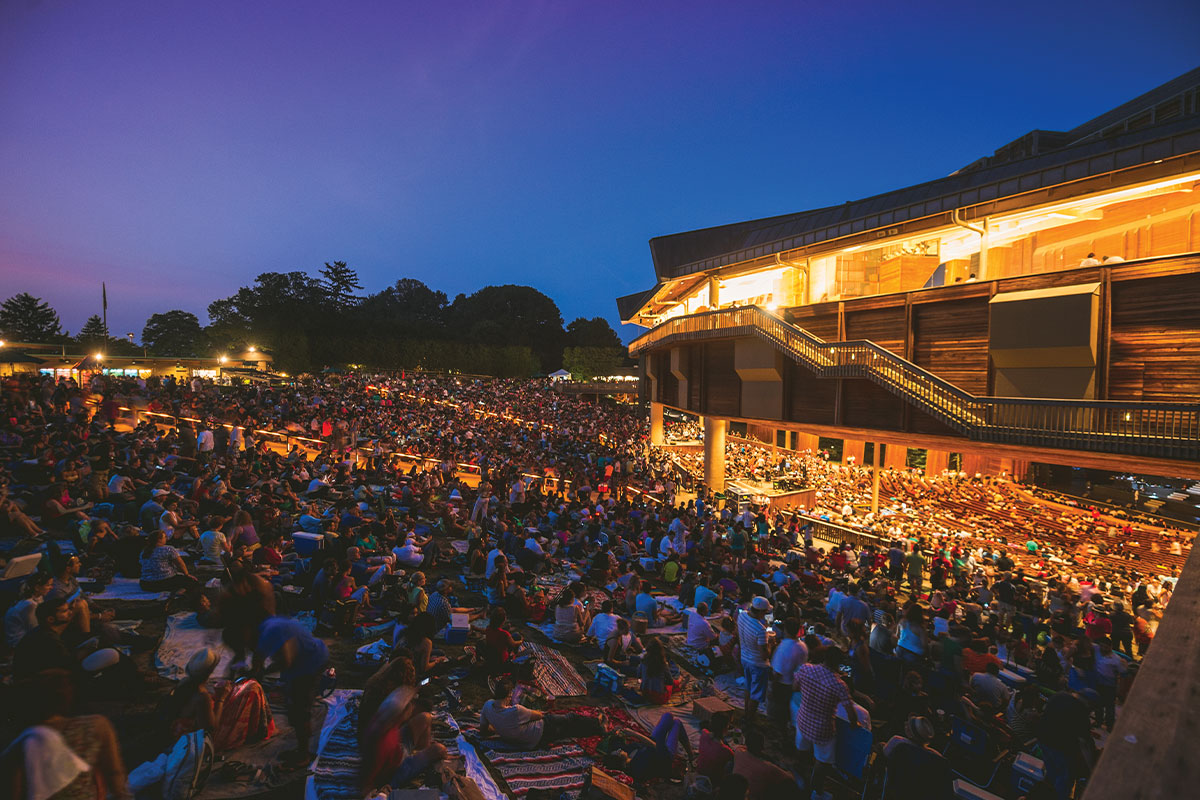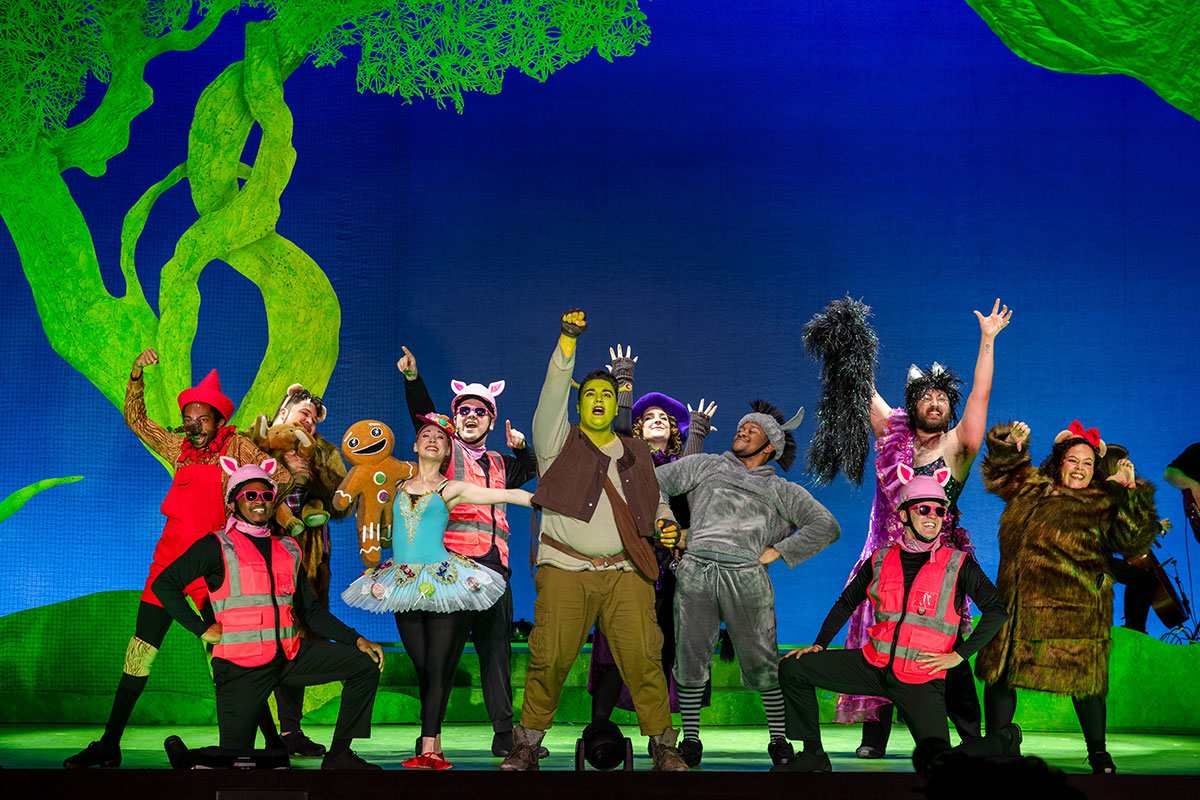
Last October, after having clocked 7,000 miles in the air, the Washington Redskins were back home from London, exhausted and frustrated. Despite a valiant effort in a contest against the Cincinnati Bengals, Washington’s beloved guys in burgundy and gold could muster nothing more than a tie. “Like kissing your sister” is how local sports pundits like to frame it.
A few days later, Larry Michael escorted a visitor through the cheery lobby of the main building at the sprawling Redskins Park campus in Ashburn. Brimming with the agility and poise of a wide receiver running a route, Michael knew all the moves, stopping and starting along the path to greet colleagues. One of them was then-general manager Scot McCloughan. After pausing a few seconds to exchange affable barbs, Michael picked up speed again. (Alas, as is so typical in the fickle world of professional sports, the Redskins fired McCloughan back in March. In the aftermath of McCloughan’s dismissal, the team promoted former Redskins Super Bowl MVP quarterback Doug Williams from senior personnel executive to the position of senior vice present of player personnel.)
Seconds later, Michael arrived at his refreshingly unpretentious office in the slice of the squat building that functions as the communications nerve center. When the conversation centers on what is far and away the capital region’s most beloved big-league sports franchise, this is the core, the reactor room. Within these four walls, with Michael at the helm, information is sourced and analyzed before it is meticulously shaped and channeled to a waiting public audience.
The typical fan who tunes in to the games on the radio might only know Michael as the rich, crackling voice at the microphone high above FedEx Field or at the other big-league football venues around the country, from Seattle to Miami, San Diego to Foxborough, Massachusetts. In fact, Michael plays other key positions in his workhorse, workaday world: senior vice president and executive producer of media for the team, which has been a dominant presence in Washington since moving here from Boston in 1937.
His voice is a few decibels below what comes forth during a game, but the same level of enthusiasm is there. Here, in his off-the-air milieu, he has the luxury of time to go deep on his life and his chosen profession.
“Never in my wildest dreams did I think I would do this for a living,” Michael says. “The last 12 years here have been extremely gratifying. There’s no better organization to work for than the Redskins,” he adds, locking his expressive, olive-rich gaze on his two visitors after inviting them to take seats harvested from the stands at FedEx. No other team, Michael says, in clipped, razor-sharp verbiage, produces the quantity of Redskins-themed programming, relying on every platform in the media universe. That includes a daily TV show, Redskins Nation, airing 52 weeks a year. “No other team, even the Yankees, do this,” he assures. “We have a real, robust newsroom.”
The short access road Michael pilots daily to Redskins Park is a low-profile affair, in many ways the antithesis of the outsize brand, one of the oldest and most valued names in the pantheon of the National Football League. For those in the know in this central Loudoun County community, surrounded not by horse farms and vineyards but by high-tech firms, handsome townhouses and the roar of jet engines from Washington Dulles, the best view into the pastoral complex is from across the way at Loudoun Water. Otherwise, you could easily and understandably mistake it for a tennis bubble.
Michael radiates a stand-alone genuineness, observed Dave Hughes. The Reston resident crafts DCRTV, the go-to website that dishes tidbits on the musical chairs played by personalities and behind-the-scenes executives in the tumultuous Washington and Baltimore media markets. “I think Larry’s cool,” Hughes says. “He has a certain style. He was put in a bad position when Frank [Herzog] went away. He’s got a tough job. He’s working for a guy who owns the team.” Hughes acknowledged that the majority of those who follow the Skins do so via television. Still, there is a distinct radio following to complement it. “Typically it’s someone driving in their car, running errands,” he says. More often than not, Hughes says, radio attracts an audience that is 50 and over. “It’s always romantic to listen to the game on the radio,” he added, which, he notes, is particularly true with baseball. Football, he says, signals “much more action.”
The beauty of radio’s portability also takes center stage when it comes to sporting events, affirms Mitchell Bradley, operations, production and program director at ESPN 950 WXHI and 100.5 WZEZ-FM in Richmond, other Daniel Snyder-owned frequencies that carry the mental brushstrokes by Michael. “There is certainly a wide array of people that listen to the Redskins on the radio,” he says. “It’s the family listening in the car on the way home from church, the dad taking his daughter to her Sunday afternoon softball game, mom running to the grocery store to get food for the week and the person who turns down the sound of the TV so he can watch the game while listening to the radio.”
Michael, says George Marafatsos, another listener, holds appeal among his audience. “People like him because he is genuine, knowledgeable and a real professional,” he says. “Larry is so gifted; he makes the game more exciting than watching it live—well, almost.”
Snatching a football from his desk, Michael, a McLean resident, married to Darlene and doting parent of two girls and a boy, tosses it in the afternoon air. The nervous energy oozes even on an otherwise ordinary Tuesday afternoon, a full five days before the next game, this one at home against the Minnesota Vikings. Making direct and continued eye contact, engulfed by Redskin paraphernalia of all manner, Michael acknowledges that he was a poor student back at Northwood High School in Silver Spring, where he graduated in 1974. He continued his studies as a law enforcement major at the University of Maryland College Park. When he heard from other students that the college radio station, WMUC, needed help, he took a shot. “Within a month, I was calling games on the campus radio station,” he says. That taste, the unfettered adrenaline rush, was all Michael needed to switch his major to radio TV and film with a minor in journalism.
That grassroots, collegiate-level training led him a dozen miles into downtown Washington, where he landed a part-time job at the Mutual Broadcasting System on 16th Street NW. “I got to go on a PGA tour as a stringer,” he says. “I didn’t want to be a director, a technical-side guy. I traveled all the around the country making $25 a day.”
From collegiate basketball to working as a low-paid stringer covering professional golfing led Michael to South Bend, Indiana, and the legendary University of Notre Dame football program, where he became part of the crew, handling pregame and halftime broadcasts. Westwood One, which owned Mutual, started out as a music distribution arm, he explains. The company president, Norm Pattiz, promoted Michael. Pattiz, he says of his old boss, “was a visionary guy. He got Westwood One into the first radio syndication in the world. We got all the rights to the NFL, Final Four, Olympics.”
His assignments for Westwood One launched a globetrotting adventure that took him as far afield as the 1980 Olympics in Lake Placid, New York, and to 1992 games in Barcelona. “I was doing basketball with Billy Packer,” he says. “They needed someone to do boxing. For the next 20 years, I got a chance to do that.” He covered championship bouts for networks like ESPN, HBO and Showtime.
By the late ’90s, he says, still fidgeting with the pigskin, Infinity Broadcasting merged with Westwood One. Infinity had purchased the radio rights to all NFL games in all of the nation’s biggest media markets, including Washington. “I got involved at the local radio station here because Mel Kamazim, another visionary, owned all the rights.” In time, WJFK-FM, the Fairfax-based outlet, tapped Michael to do the pregame, halftime and postgame shows.
In 2004, WJFK obtained the radio rights for the Redskins, and Michael was given the play-by-play job. Contractually, he says, “it was part of my obligation. What they were looking for was someone to do sales appearances and chalk talks. In 2005, they hired me full time.”
As the new broadcaster who replaced the storied Frank Herzog, who had called the Redskins games for years, Michael was given instructions by team owner Daniel Snyder and then-head coach Joe Gibbs. “They wanted unfiltered access to the team. Rather than show a 10-second sound bite out of context, we showed all of our press conferences. I was hired to open a TV production company. I also quit as the voice of the George Washington Colonials, and I quit Westwood One.”
Michael totes a plethora of weapons in his playbook. One of the most potent is the care he invests in preparation, says the iconic Sonny Jurgensen, the Hall of Famer who quarterbacked the burgundy and gold from 1964 until he retired a decade later. “He does his homework. He’s got his charts ready. That’s one thing you admire about him,” says Jurgensen, 82, who offers color commentary on the radio along with former tight end Chris Cooley. Prior to each game, he explains, the announcing crew must secure background information from the opposition in order to give a full-form analysis. “You go over their players, their record. If you have any questions, you ask Larry.”
Stepping into the formidable shoes of someone like Herzog was not intended for the faint of heart, says Gerry Sandusky, who calls the Ravens radio games on WBAL-AM and WIYY, its FM sister. Herzog, he says, “had the good fortune of calling games during the Redskins glory year. Winning usually makes fans get far more attached to announcers because their voices become linked to a positive experience. To Larry’s credit, he didn’t try to replace Frank. He carved out his own niche and developed his own style. That takes courage and consistency.”
Considered from the vista of sensory arousal, Sandusky declares that vast differences exist between describing football on the radio and the TV product. “On TV, the picture and the graphics take care of the framework—the down and distance, the score, the amount of time remaining in the quarter, the half or the game. They are all right there for the viewer to see. The other big difference is on TV you have to talk about what’s on the screen. If the director has called up a shot of the opposing head coach, you need to angle your comments in that direction, too. On radio, the play-by-play announcer is the director. He chooses what to talk about and when to talk about it. And as long as he does a good job of painting a picture, the listener is able to see it.”
While Michael is the subject of a steady stream of accolades for his full-on approach to his craft, one longtime observer of the local media scene contends he finds himself on a proverbial tightrope. The fact that Michael works for the same person who owns the team and the radio station that carries the games can be complicated, says Marc Fisher, a senior editor at The Washington Post. “Anyone who is doing play-by-play wants to be objective, or should be objective,” says Fisher, author of Something in the Air: Radio, Rock, and the Revolution That Shaped a Generation. To what extent Michael has his marching orders to amp up his role as hometown cheerleader is hard to put his arms around. “It’s hard to know from the outside if that’s something that’s coming from on high.”
Fisher, who writes about national, foreign and local matters, recalls when popular Orioles play-by-play man Jon Miller was fired by team owner Peter Angelos. But Miller landed on his feet, returning to his native San Francisco Bay area, where he returned to the booth. With the retirement of Vin Scully this year as the voice of the Los Angeles Dodgers, Fisher believes Miller is the premiere voice in the play-by-play game. “He’s at the top of the heap.”
However, Fisher quickly adds that Michael had a tough act to follow when he replaced Frank Herzog in the broadcast booth. “The way Frank, Sonny (Jurgensen) and Sam (Huff, a former Redskins linebacker) worked together, they were people listeners liked to hang out with.”
While Paul Eldridge said he is well-equipped to watch all the Redskins games on TV in his Fairfax home, he prefers taking the intimate approach, harvesting a bumper crop of seamless images on WTEM-AM and the other stations down the line that compose the Redskins radio network. “Every time an athlete performs, Larry’s there to say words about it and to help me understand why I prefer to listen rather than watch,” says Eldridge, 32, a technical program manager in the area of security and trust for Salesforce in Herndon. “Radio helps me understand what’s going on in a more abstract way. I don’t have to actually see the game. I just have to pretend to see it, which is arguably much more interesting.”
Says the Rev. Steven Zorzos, who pastors St. Sophia Greek Orthodox Cathedral in Northwest Washington: “Larry’s mellifluous voice resonates with the timbre reminiscent of that of the great longtime Yankee Stadium announcer Bob Sheppard. It’s something ethereal and heavenly, like murmuring clouds. His job is extremely difficult. Larry must always balance his devoted commitment to the Washington Redskins with the truth of the game. It is not at all easy to root for your beloved team, who happens to be your employer, and objectively criticize shortcomings and failures as they arise.”
Jeff Bostic, who played center for the Redskins for 14 seasons before retiring after the 1993 season, says he treasures Michael’s loyalty to the region and to the Redskins brand. And although Bostic, 58, has lived in the Atlanta area for the past 17 years as a general partner in a company that builds apartments, he says: “Larry’s like I was. I tell people, ‘I’m a Redskin for life.’ Larry will be a Redskin for life.”
Dave Johnson says he’s known Michael for more than 25 years and likes what he sees. “Larry is a true professional,” says Johnson, news director at WTOP radio and veteran radio play-by-play announcer for the Washington Wizards. “I remember when we were both doing shows at the old Home Team Sports and busy with other jobs as well. I have always admired Larry’s work ethic and drive. It doesn’t matter what sport he is calling games for or talking about, Larry is always prepared and is an easy listen.” In the most intimate of mediums, Johnson remarks, Michael succeeds in corralling the listener in on the discussion unfolding through a bird’s-eye lens. “A listener wants to be informed and entertained, and Larry strikes the balance.”
Rick “Doc” Walker, who played tight end for the Redskins under coach Joe Gibbs, says in order to be an effective broadcast team, you have to regard your partners in the booth “as your brothers. You’re competing with 32 other (broadcasting) groups,” in the NFL, “but we want to be the best.” As for Michael, Walker says, it is he who must quarterback the voices that crackle over the air and into the hearts and minds of the fandom. After the intense culling of morsels that frame college and professional careers, come game day, it is Michael who takes the snap. “He’s got the hardest job,” Walker says. “He’s got to say it first. He’s got to know all the right pronunciations.”
The product of hardworking immigrants from the Peloponnese region of southern Greece stands and gently grips a framed photo of his late father, Perry, who owned a small grocery store in suburban Maryland and who served as a role model for his children when it came to emphasizing the importance of sporting a civic-minded conscience. “Being of Greek ancestry,” Michael says softly, on the verge of tears, “my father was so proud. He would embarrass me a lot. When we would go out to eat, he would tell people, ‘By the way, my son’s the voice of the Redskins!’ Never in my wildest dreams did I think I would do this for a living. The passion of my Greek father—when I made $25 a day on the PGA tour, he wasn’t very happy. But he was proud to say I was his son.”
As Michael composes himself for a staff meeting before taping his popular daily TV show, Redskins Nation, he harnesses his street cred and his lifelong love of the Redskins long enough to contemplate a final thought. With commuters losing faith in the reliability of the crumbling Metro system, that leaves the Redskins as the powerfully unifying force that entwines a federal city and two adjacent states that are otherwise physically and psychologically separated by the Potomac River.
“When we win, it produces a common feeling among the fans,” he says. “It’s euphoric. Everybody is experiencing the same emotion. And a big part of it comes from the work produced in this building.”




